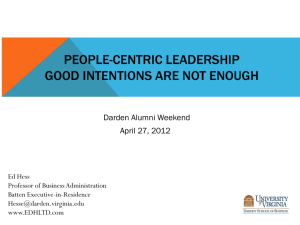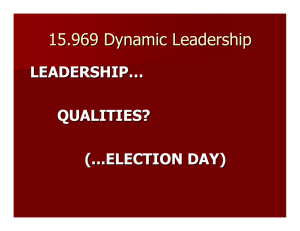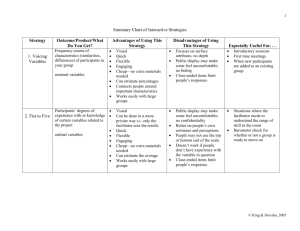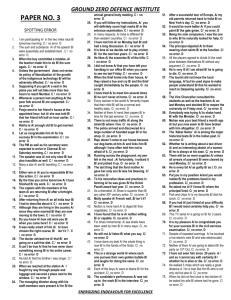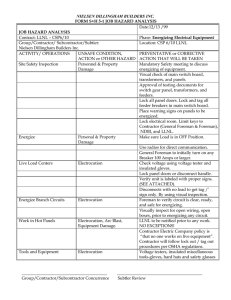Presentation from Fiji Electricity Authority
advertisement
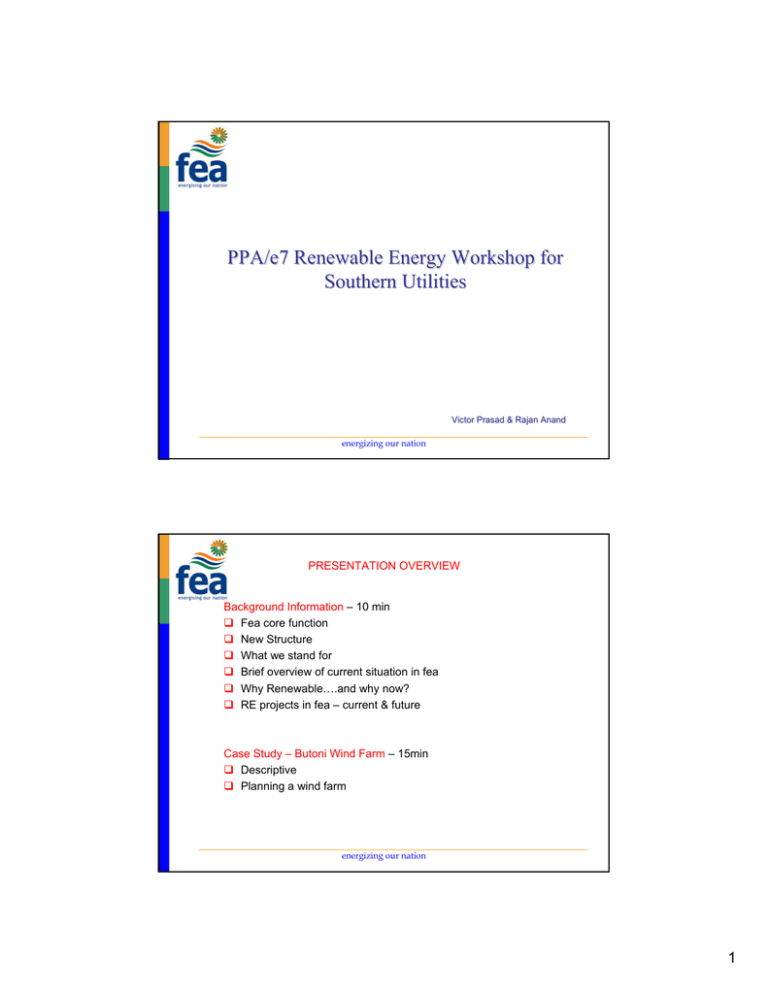
PPA/e7 Renewable Energy Workshop for Southern Utilities Victor Prasad & Rajan Anand energizing our nation PRESENTATION OVERVIEW Background Information – 10 min Fea core function New Structure What we stand for Brief overview of current situation in fea Why Renewable….and why now? RE projects in fea – current & future Case Study – Butoni Wind Farm – 15min Descriptive Planning a wind farm energizing our nation 1 CONSTITUTION & CORE FUNCTION • The Fiji Electricity Authority (fea) was established, incorporated and constituted under the provisions of the Electricity Act of 1966 and began operations from August 1st of that year. The fea is responsible for generating, transmitting and retailing electricity in Fiji • Members of the Board approved by the Minister of Works and Energy. • CEO is responsible to the Members for the Authority’s management and for execution of its policies • The powers, functions and duties of the Authority under the Electricity Act are for the basic purpose of providing and maintaining a power supply that is financially viable economically sound and consistent with the required standards of safety, security and quality of power supply energizing our nation CONSTITUTION & CORE FUNCTION • A uniform tariff rate is charged for electricity used by each consumer group. The tariffs are fixed according to government policy. • • • • Domestic lifeline tariff (<250kwh/month) Domestic other tariff (>250kwh/month) Commercial & industrial tariff (up to 14,999kwh) Commercial & industrial tariff (>14,999kwh) 20.59c 21.27c 22.14c 20.00c • The Authority is also entrusted with enforcing the Electricity Act and regulations, setting standards, examining and registering electricians, and is empowered to approve and license suppliers to serve certain areas. • Fea is also governed by the requirements under the Public Enterprise Act energizing our nation 2 energizing our nation energizing our nation 3 VISION, MISSION & VALUES An image of our desired future : “Energising our people and our Nation” What FEA is here to do : Vision “We will provide clean and affordable energy solutions to Fiji and the Pacific. We aim to provide all energy through renewable resources by 2011” Mission How we intend to operate as we pursue our vision: Values Customer focused •Honesty •Courage to do what is right for FEA •Team work •Individual accountability •Transparency •Innovativeness energizing our nation energizing our nation 4 energizing our nation CURRENT STATUS • • • • • • • • • • • • • Installed capacity Rated Thermal Hydro IPP’s Maximum demand Energy production (2004) Number of customers Growth rate Transmission/ distribution system Total 132KV line Total 33KV line 11KV & below Domestic other tariff (>250kwh/month) 180 MW 88 MW 80 MW 10 MW 111 MW 650 GWh 135,000 5.5% /annum 132KV, 33KV, 11KV and below 143km 322km 6,200km 21.27c energizing our nation 5 WHY RENEWABLE…….& WHY NOW?? energizing our nation fea’s DRIVE FOR RENEWABLE ENERGY • To comply with Kyoto Protocol on reducing green house gases - (each MW • To benefit from Clean Development Mechanism • For Fiji’s electricity prices to remain competitive hour of electricity generated in Fiji produces 0.69tonnes of greenhouse gas pollution) – Rapidly increasing diesel fuel burn – Substantial exposure to highly volatile global oil market with risk of high and volatile diesel prices • To reduce foreign exchange leakage out of Fiji – EXORBITANT PRICES!! • And to be innovative and think outside the box energizing our nation 6 DEMAND SUPPLY PROJECTION 160 140 Unrel diesel Exist Diesel 120 Sigatoka Ba FSC Rarawai MW 100 Butoni Tropic Woods 80 New Diesel Vaturu 60 Wainikasou Exist Other 40 Hydro MD 20 0 2004 2005 2006 2007 2008 2009 2010 energizing our nation OUTCOME OF CURRENT INITIATIVES Potential replacement for diesel: • Geothermal • Gasification 1000 •Mini hydros 900 800 • Wind 700 FEA Diesel GWh 600 • Solar IPP Other Fuel •Co-generation 500 400 300 FEA Renewable Energy 200 100 0 2004 2005 2006 2007 2008 2009 2010 energizing our nation 7 AVERAGE COST OF DIESEL $1,200.00 $8,000,000.00 $6,000,000.00 $5,000,000.00 $600.00 $4,000,000.00 $3,000,000.00 $400.00 $2,000,000.00 $200.00 $1,000,000.00 Sep '05 Jul '05 Aug '05 Jun '05 Apr '05 May '05 Mar '05 Jan '05 Feb '05 Dec '04 Oct '04 FJD per MT Nov '04 Sep '04 Jul '04 Aug '04 Jun '04 Apr '04 May '04 Mar '04 $Jan '04 $Feb '04 FJD per MT $800.00 Diesel use per month $7,000,000.00 $1,000.00 Diesel usage energizing our nation energizing our nation 8 energizing our nation Dam Level (masl) MONASAVU DAM LEVELS 750 748 746 744 742 740 738 736 734 732 730 728 726 724 722 720 718 716 714 712 710 708 Jan Maximum Dam Level 2004 2002 2005 2003 Safe Minim um Level Absolute Minim um Operating Level Feb Mar Apr May Jun Jul Aug Sept Oct Nov Dec Months energizing our nation 9 AVERAGE DEMAND PROFILES 120.0 110.0 Jan 100.0 Feb 90.0 Mar Apr Load (MW) 80.0 May 70.0 Jun 60.0 Aug Jul Sep 50.0 Oct Nov 40.0 Dec Max 30.0 Min Peak 20.0 10.0 0.0 0.02 0.06 0.1 0.15 0.19 0.23 0.27 0.31 0.35 0.4 0.44 0.48 0.52 0.56 0.6 0.65 0.69 0.73 0.77 0.81 0.85 0.9 0.94 0.98 Time of Day energizing our nation Independent Power Producer Interest Studio city (5) Rakiraki Tavua Ba Lautoka Elpicon (40) Emperor (5) FSC(15) Tropik(9) Nadarivatu (54) Solar (1) Vuda Wailoa Vaturu Denarau (5) Nadi Momi(9) Bula Marina(10) Natadola(8) Fj_Hwd(5) Navua Butoni (10) Sigatoka Suva IRD (5) Korolevu Deuba IRD_Naboro (5) Load Centres Cities & Towns New generation energizing our nation 10 RENEWABLE ENERGY PROJECTS Rakiraki Tavua Ba Navutu Solar Project ☺ 1MW (2006) Lautoka Waqadra Ovalau Nadarivatu HE Project 45 - 55MW (2007) Vuda Wainikasou HE Project 6.5MW (2004) Vaturu HE Project 3.2MW (2005) Nadi Ovalau Wind Project 250KW (2006) Wailoa Momi Natadola Sigatoka Kinoya Butoni Wind Farm 10MW (2006) Deuba Korolevu Suva energizing our nation RENEWABLE ENERGY PROJECTS Savusavu Wind Project (2006) energizing our nation 11 NADARIVATU HE PROJECT Nadarivatu 1 Power Station Nadarivatu Dam Tunnels & Penstock Nadarivatu 2 Power Station Ex 132KV line energizing our nation POWER GENERATION SCHEME LAYOUT energizing our nation 12 NAVUTU SOLAR PROJECT 10KW Navutu Depot setup Area = 94m2 Contains 140 panels Generated (average) 8.25 KWh per year energizing our nation energizing our nation 13 RENEWABLE DEVELOPMENTS Project Project capacity Milestones $ value Wainikasau - Hydro 6MW Completion by May 2004 $10M Vaturu - Hydro 2.8MW Commence May ’04 (SEL) PWD to complete Jan ‘06 $5.5M Butoni Wind Farm 10MW Construction to start in November End in December 06 $32M 45 - 55MW 2006 start and completion by Aug 2008 $150M 1MW RFT Stage ?? Geothermal ?? Studies under way ?? Bioenergy options (Biofuel & Biomass) ?? Studies under way – coconut oil trials, biomass options, vegetable oil potential ?? Mini Hydro options ?? RE atlas underway in 3rd quarter 3 potential projects energizing our nation ?? Nadarivatu Hydro Solar - Navutu Butoni Wind Farm – fea’s first wind farm energizing our nation 14 energizing our nation BUTONI SITE Nadi Airport Wind FarmSite energizing our nation 15 BUTONI WIND FARM • • • • • • • • • • • Low–moderate wind speed conditions (av. 5.46 m/s) Short-term data set only (less than a year) Moderate correlation to Nadi airport – low wind Narrow north-south ridge 5-6 kms from Sigatoka Located along Butoni hill ridge, behind Sigatoka Town 37 Turbines, 55m high, 2 blade structure 275kW each, 10.175 MW in total ( 13% capacity factor) 11.5GWh annually (2% of current annual supply to Viti Levu) Operates in wind speeds 4 - 20m/s Can be lowered to ground in response to cyclone warnings, and reerected – approx 40 min Require up to 5 full time equivalent staff to maintain / operate energizing our nation Vergnet •Supplier of water and wind energy systems – niche player •Supply 40 million people with clean water (mainly Africa) •Supply 100 wind turbines per year worldwide •Wind turbines in 20 kW, 60 kW and 275 kW sizes energizing our nation 16 energizing our nation TECHNOLOGY PREFERENCE Technically, Vergnet is ideal for our situation due to: •Size of Machine – 275 kW (not too big for grid integration) •Anti-cyclonic protection •Light lifting equipment required •Proximity in New Caledonia •No Heavy Crane •Guyed supports •On ground assembly and maintenance energizing our nation 17 MAIN STEPS IN DEVELOPING A WIND FARM 1. 2. 3. 4. 5. 6. 7. 8. 9. 10. 11. 12. 13. 14. 15. 16. Wind monitoring mast installed (approx. 30 – 50m) Preliminary baseline flora & fauna assessment Preliminary baseline cultural heritage Preliminary development envelope (typical generator layout) Environmental protection conservation act referral (EMP) Detailed initial impact studies – floura &fauna assessment, avi-fauna, cultural heritage assessment, acoustic assessment, visual impact, shadow flicker, TV interference Local consultation – socio economic study Submit application Community comment (stakeholders) Application approved Final local impact studies Detailed EMP for construction (CEMP) Commercial agreements signed – LOU Construction Commissioning O&M energizing our nation PLANNING A WIND FARM 1. 2. 3. 4. 5. 6. 7. 8. 9. 10. Quality wind data – have you got sufficient information and is the wind consistent Impact on environment – “nimby” phenomenon Acoustic effects – once people know a project is on the way, new houses get built – compensation issues Best to do baseline studies to avoid compensation issues after (do tests before and after) Archaeological sites – Fijian way was to bury their loved ones under their houses. So avoid house mounds – compensation issues Consider climatic conditions – Fiji has an average of 3 -4 cyclones per year Terrain – ask yourself whether a project is possible. Sizing turbines – always consider lifting capabilities in your country after the project and consider the weather. Spare parts – how much do you keep on the books (commercial decision) Grid connection – is grid connection possible? Is grid in close proximity? Can your system take the power generated from a WTG? energizing our nation 18 PLANNING A WIND FARM 11. 12. 13. 14. 15. 16. 17. 18. 19. 20. O & M – have you got expertise in the country? How far away is help? Good access for construction vehicle and machinery is essential (contractors concentrate on the WF and forget access is an integral part of the project) Storage issues – need good storage facilities for the rotor and nacelle Road and traffic management – are your loads sufficiently designed to take the huge loads. Need to do traffic study and bridge count. Need to check bending radius What are you capabilities after contractor leaves project site? Survey plans – are your Lands department plans correct? What contour maps do you have? Need detailed contour maps. Is large area available for optimum spacing of WTG (only 1% land taken up) No risk sharing from local contractors Need to do a risk management exercise together with all parties for the good of the project Landowners & local community – need to get a good feel before you commit – single most critical factor!! energizing our nation PLANNING A WIND FARM 21. 22. 23. 24. 25. 26. 27. 28. 29. 30. Communication protocols – grid code issues Need good working drawings – different countries have different standards. In the Pacific, we generally follow Australia 7 NZ standards Have a well defined contract – deal with issues like Liquidated damages, penalty and bonuses well Have to make safety the number one priority – need alignment with other organisations Need a project management plan, engineering management plan, quality management plan and maybe a safety plan Need a dedicated Project manager – one focus 80 – 20 rule :80% time is spent planning the plan, 20% is spent working the plan. Contracts best managed as a Turn key contract rather than reducing scope for principal contractor. Establish rules of communication early! Government incentives and Duty and tax issues Transmission component of the WF project – easy to lose focus. energizing our nation 19 energizing our nation HISTORY OF A PROJECT energizing our nation 20 The Saga!! energizing our nation THANK YOU energizing our nation 21
